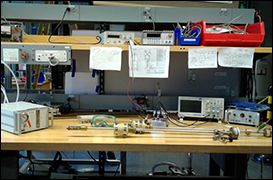Description

Superconductivity experiment equipment.
Several phenomena associated with superconductivity are observed in three experiments carried out in a liquid helium cryostat. The transition to the superconducting state of each of several bulk samples of Type I and II superconductors is observed in measurements of the exclusion of magnetic field (the Meisner effect) from samples as the temperature is gradually reduced by the flow of cold gas from boiling helium. The persistence of a current induced in a superconducting cylinder of lead is demonstrated by measurements of its magnetic field over a period of a day. The tunneling of Cooper pairs through an insulating junction between two superconductors (the DC Josephson effect) is demonstrated, and the magnitude of the fluxoid is measured by observation of the effect of a magnetic field on the Josephson current.
Lab Guide
Superconductivity Lab Guide (PDF)
References
London, F., and H. London. “The Electromagnetic Equations of the Superconductor.” Reprinted from Proceedings of the Royal Society London A149 (1935): 71-88.
Bommel, H. E. “Ultrasonic Attenuation in Superconducting Lead.” The Physical Review 96, no. 1 (October 1954): 79-81.
Corak, W. S., B. B. Goodman, C. B. Satterwaite, and A. Wexler. “Atomic Heats of Normal and Superconducting Vanadium.” The Physical Review 102, no. 3 (May 1956): 43-48.
Bardeen, J., L. N. Cooper, and J. R. Schrieffer. “Theory of Superconductivity.” The Physical Review 108, no. 5 (1957): 1175-1204.
Crowe, J. W. “Trapped-Flux Superconducting Memory.” Reprinted from IBM Journal of Research and Development 1 (1957): 295-303.
Cooper, Leon N. “Theory of Superconductivity.” American Journal of Physics 28, no. 2 (February 1960): 91-101.
Knuzler, J. E., E. Buehler, F. S. L. Hsu, and J. H. Wernick. “Superconductivity in Nb3Sn at High Current Density in a Magnetic Field of 88 kgauss.” The Physical Review Letters 6, no.3 (1961): 89-91.
Landau, Lev Davidovic. “Nobel Prize.” (1962). (For his pioneering theories for condensed matter, especially liquid helium.)
Ginsberg, D. M. “Resource Letter Scy-1 on Superconductivity.” American Journal of Physics 32, no. 2 (February 1964): 1-5.
American Association of Physics Teachers. Superconductivity: Selected Reprints. New York: Published for the American Association of Physics Teachers by the American Institute of Physics, 1964.
Feynman, Richard P. “A Seminar on Superconductivity.” Chapter 21 in Feynman Lectures on Physics. Vol. III. Reading, MA: Addison-Wesley, 1965. ISBN:9780201020106.
Parks, R. D. “Quantum Effects in Superconductors (PDF).” Scientific American 213, no. 4 (October 1965): 57-67.
Bardeen, John. Nobel Prize Lecture, “Electron-Phonon Interactions and Superconductivity.” (1972).
Cooper, Leon N. Nobel Prize Lecture, “Microscopic Quantum Interference Effects in the Theory of Superconductivity.” (1972).
Schrieffer, J. Robert. Nobel Prize Lecture, “Macroscopic Quantum Phenomena from Pairing in Superconductors.” (1972).
Bardeen, J. “Electron-phonon Interactions and Superconductivity.” Physics Today 26 (1973): 41-46.
Esaki, Leo. Nobel Prize Lecture, “Long Journey into Tunnelling.” (1973).
Giaever, Ivar. Nobel Prize Lecture, “Electron Tunneling and Superconductivity.” (1973).
Josephson, Brian D. Nobel Prize Lecture, “The Discovery of Tunnelling Supercurrents.” (1973).
Cooper, Leon N. “Microscopic Quantum Interference in the Theory of Superconductivity.” Physics Today 26 (July 1973): 31-39.
Schrieffer, J. R. “Macroscopic Quantum Phenomena from Pairing in Superconductors.” Physics Today 26 (July 1973): 23-28.
Tinkham, Michael. Introduction to Superconductivity. New York, NY: McGraw-Hill, 1975, 151 pages. ISBN: 9780070648777.
Bednorz, Johannes Georg, and Karl Alexander Müller. “Possible High Tc Superconductivity in the Ba-La-Cu-O System.” Condensed Matter, Zeitschrift Für Physik B. 64, no. 2 (1986) 189-193.
Josephson Effects References
Josephson, B. D. “Coupled Superconductors.” Reviews of Modern Physics 36, no. 1 (1963): 216-220.
Langenberg, D. N., D. J. Scalapino, and B. N. Taylor. “The Josephson Effects (PDF).” Scientific American 214, no. 5 (May 1966): 30-39.
Richards, P. L., S. Shapiro, and C. C. Grimes. “Student Laboratory Demonstration of Flux Quantization and the Josephson Effect in Superconductors.” American Journal of Physics 36, no. 8 (August 1968): 690-697.
Clarke, J. “The Josephson Effect and e/h.” American Journal of Physics 38, no. 9 (September 1970): 1071-1092.
Scalapino, D. J. “Josephson Effects.” [1970] In Encyclopedia of Physics. Edited by Rita G. Lerner and George L. Trigg. Reading, MA: Addison-Wesley, 1981, pp. 479-481. ISBN: 9780201043136.
Bruynseraede, Y., C. Vlekken, and C. Van Haesendonck. “Giaever and Josephson Tunneling.” In Superconducting Electronics. NATO ASI Series. vol. F59_._ Springer-Verlag, 1989.








